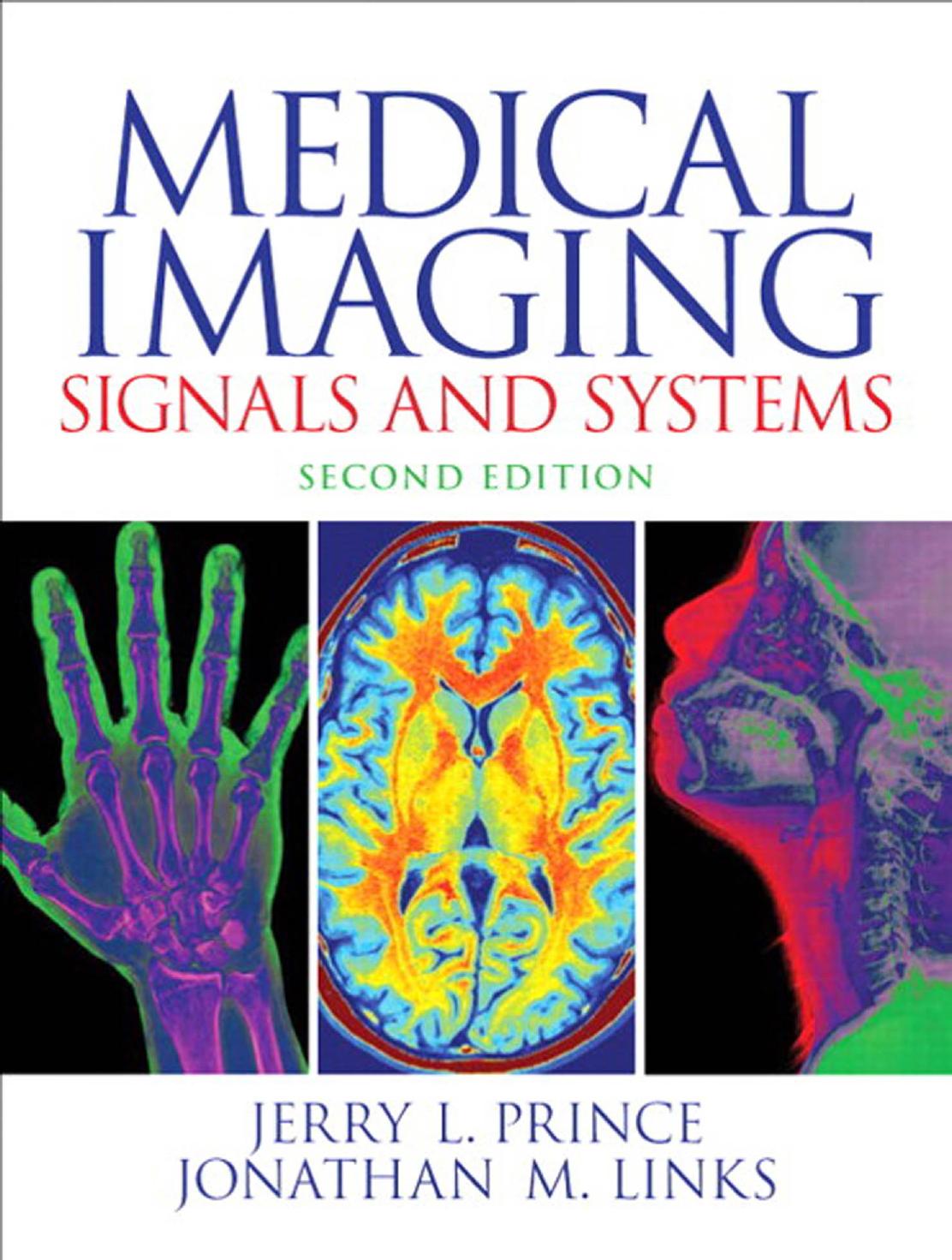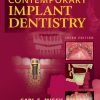Medical Imaging Signals and Systems 2nd Edition by Jerry Prince, Jonathan Links ISBN 0132145189 9780132145183
$70.00 Original price was: $70.00.$35.00Current price is: $35.00.
Instant download Medical Imaging Signals and Systems 2nd Edition by Jerry L. Prince after payment
Medical Imaging Signals and Systems 2nd Edition by Jerry Prince, Jonathan Links – Ebook PDF Instant Download/Delivery: 0132145189, 9780132145183
Full dowload Medical Imaging Signals and Systems 2nd Edition after payment

Product details:
ISBN 10: 0132145189
ISBN 13: 9780132145183
Author: Jerry L. Prince; Jonathan Links
This is the eBook of the printed book and may not include any media, website access codes, or print supplements that may come packaged with the bound book. This tet is designed for courses in medical imaging systems. It is also suitable for professionals seeking an overview of medical imaging systems. With signal processing as its foundation, Medical Imaging Signals and Systems, Second Edition covers the most important imaging modalities in radiology: projection radiography, -ray computed tomography, nuclear medicine, ultrasound imaging, and magnetic resonance imaging. Organized into parts to emphasize key overall conceptual divisions, Medical Imaging is most appropriate for engineering students who have taken the prerequisite signals and systems courses as well as elementary probability. This program presents a better teaching and learning eperience—for you and your students. Teach with a dynamic art program: The tet’s wealth of images and diagrams help students visualize key concepts. Capture students’ attention: Motivational eample problems both keep students focused and reveal interesting features. Use relevant material: Biologically relevant eamples illustrate the important contet of medical imaging.
Medical Imaging Signals and Systems 2nd Table of contents:
Part I Basic Imaging Principles
Overview
Chapter 1 Introduction
1.1 History of Medical Imaging
1.2 Physical Signals
1.3 Imaging Modalities
1.4 Projection Radiography
1.5 Computed Tomography
1.6 Nuclear Medicine
1.7 Ultrasound Imaging
1.8 Magnetic Resonance Imaging
1.9 Multimodality Imaging
1.10 Summary and Key Concepts
Further Reading
Chapter 2 Signals and Systems
2.1 Introduction
2.2 Signals
2.2.1 Point Impulse
2.2.2 Line Impulse
2.2.3 Comb and Sampling Functions
2.2.4 Rect and Sinc Functions
2.2.5 Exponential and Sinusoidal Signals
2.2.6 Separable Signals
2.2.7 Periodic Signals
2.3 Systems
2.3.1 Linear Systems
2.3.2 Impulse Response
2.3.3 Shift Invariance
2.3.4 Connections of LSI Systems
2.3.5 Separable Systems
2.3.6 Stable Systems
2.4 The Fourier Transform
2.5 Properties of the Fourier Transform
2.5.1 Linearity
2.5.2 Translation
2.5.3 Conjugation and Conjugate Symmetry
2.5.4 Scaling
2.5.5 Rotation
2.5.6 Convolution
2.5.7 Product
2.5.8 Separable Product
2.5.9 Parseval’s Theorem
2.5.10 Separability
2.6 Transfer Function
2.7 Circular Symmetry and the Hankel Transform
2.8 Summary and Key Concepts
Further Reading
Problems
Signals and Their Properties
Systems and Their Properties
Convolution of Signals
Fourier Transforms and Their Properties
Transfer Function
Applications, Extensions, and Advanced Topics
Chapter 3 Image Quality
3.1 Introduction
3.2 Contrast
3.2.1 Modulation
3.2.2 Modulation Transfer Function
3.2.3 Local Contrast
3.3 Resolution
3.3.1 Line Spread Function
3.3.2 Full Width at Half Maximum
3.3.3 Resolution and Modulation Transfer Function
3.3.4 Subsystem Cascade
3.3.5 Resolution Tool
3.3.6 Temporal and Spectral Resolution
3.4 Noise
3.4.1 Random Variables
3.4.2 Continuous Random Variables
3.4.3 Discrete Random Variables
3.4.4 Independent Random Variables
3.5 Signal-to-Noise Ratio
3.5.1 Amplitude SNR
3.5.2 Power SNR
3.5.3 Differential SNR
3.5.4 Decibels
3.6 Sampling
3.6.1 Signal Model for Sampling
3.6.2 Nyquist Sampling Theorem
3.6.3 Anti-Aliasing Filters
3.7 Other Effects
3.7.1 Artifacts
3.7.2 Distortion
3.8 Accuracy
3.8.1 Quantitative Accuracy
3.8.2 Diagnostic Accuracy
3.9 Summary and Key Concepts
Further Reading
Problems
Contrast
Resolution
Random Variables and Noise
Sampling Theory
Artifacts, Distortion, and Accuracy
Applications, Extensions and Advanced Topics
Part II Radiographic Imaging
Overview
Chapter 4 Physics of Radiography
4.1 Introduction
4.2 Ionization
4.2.1 Atomic Structure
4.2.2 Electron Binding Energy
4.2.3 Ionization and Excitation
4.3 Forms of Ionizing Radiation
4.3.1 Particulate Radiation
4.3.2 Electromagnetic Radiation
4.4 Nature and Properties of Ionizing Radiation
4.4.1 Primary Energetic Electron Interactions
4.4.2 Primary Electromagnetic Radiation Interactions
Photoelectric Effect
Compton Scattering
Probability of EM Interactions
4.5 Attenuation of Electromagnetic Radiation
4.5.1 Measures of X-Ray Beam Strength
4.5.2 Narrow Beam, Monoenergetic Photons
4.5.3 Narrow Beam, Polyenergetic Photons
4.5.4 Broad Beam Case
4.6 Radiation Dosimetry
4.6.1 Exposure
4.6.2 Dose and Kerma
4.6.3 Linear Energy Transfer (LET)
4.6.4 The f-Factor
4.6.5 Dose Equivalent
4.6.6 Effective Dose
4.7 Summary and Key Concepts
Further Reading
Problems
Physics of Atoms
Ionizing Radiation
Attenuation of EM Radiation
Radiation Dosimetry
Chapter 5 Projection Radiography
5.1 Introduction
5.2 Instrumentation
5.2.1 X-Ray Tubes
5.2.2 Filtration and Restriction
Filtration
Restriction Beam
5.2.3 Compensation Filters and Contrast Agents
Compensation Filters
Contrast Agents
5.2.4 Grids, Airgaps, and Scanning Slits
Grids
Airgaps
Scanning Slits
5.2.5 Film-Screen Detectors
Intensifying Screens
Radiographic Film
Radiographic Cassette
5.2.6 X-Ray Image Intensifiers
5.2.7 Digital Radiography
Computed Radiography Systems
CCD-Based Digital Radiography Systems
Thin-Film-Transistor-Based Digital Radiography Systems
CMOS-Based Digital Radiography Systems
Wireless and Rechargable DR Detectors
5.2.8 Mammography
5.3 Image Formation
5.3.1 Basic Imaging Equation
5.3.2 Geometric Effects
Inverse Square Law
Obliquity
Beam Divergence and Flat Detector
Anode Heel Effect
Path Length
Depth-Dependent Magnification
Imaging Equation with Geometric Effects
5.3.3 Blurring Effects
Extended Sources
Film-Screen and Digital Detector Blurring
5.3.4 Film Characteristics
5.4 Noise and Scattering
5.4.1 Signal-to-Noise Ratio
5.4.2 Quantum Efficiency and Detective Quantum Efficiency
Quantum Efficiency
Detective Quantum Efficiency
5.4.3 Compton Scattering
Effect on Image Contrast
Signal-to-Noise Ratio with Scatter
5.5 Summary and Key Concepts
Further Reading
Problems
Instrumentation
Image Formation
Image Quality
Applications
Chapter 6 Computed Tomography
6.1 Introduction
6.2 CT Instrumentation
6.2.1 CT Generations
6.2.2 X-Ray Source and Collimation
6.2.3 Dual-Energy CT
6.2.4 CT Detectors
6.2.5 Gantry, Slip Ring, and Patient Table
6.3 Image Formation
6.3.1 Line Integrals
6.3.2 CT Numbers
6.3.3 Parallel-Ray Reconstruction
Geometry
Sinogram
Backprojection
Projection-Slice Theorem
The Fourier Method
Filtered Backprojection
Convolution Backprojection
Reconstruction in Three Steps
6.3.4 Fan-Beam Reconstruction
Geometry
Fan-Beam Reconstruction Formula
Fan-Beam Convolution Backprojection
6.3.5 Helical CT Reconstruction
6.3.6 Cone Beam CT
6.3.7 Iterative Reconstruction
6.4 Image Quality in CT
6.4.1 Resolution
6.4.2 Noise
Measurement Statistics
Image Statistics
Image SNR
6.4.3 Artifacts
Aliasing
Beam Hardening
Other Artifacts
6.5 Summary and Key Points
Further Reading
Problems
Instrumentation
Radon Transform
CT Reconstruction
Image Quality
Applications and Advanced Topics
Part III Nuclear Medicine Imaging
Overview
Chapter 7 The Physics of Nuclear Medicine
7.1 Introduction
7.2 Nomenclature
7.3 Radioactive Decay
7.3.1 Mass Defect and Binding Energy
7.3.2 Line of Stability
7.3.3 Radioactivity
7.3.4 Radioactive Decay Law
7.4 Modes of Decay
7.4.1 Positron Decay and Electron Capture
7.4.2 Isomeric Transition
7.5 Statistics of Decay
7.6 Radiotracers
7.7 Summary and Key Concepts
Further Reading
Problems
Fundamentals of Atoms
Radioactive Decay and Its Statistics
Radiotracers
Chapter 8 Planar Scintigraphy
8.1 Introduction
8.2 Instrumentation
8.2.1 Collimators
8.2.2 Scintillation Crystal
8.2.3 Photomultiplier Tubes
8.2.4 Positioning Logic
8.2.5 Pulse Height Analyzer
8.2.6 Gating Circuit
8.2.7 Image Capture
8.2.8 Solid State and Other New Cameras
8.3 Image Formation
8.3.1 Event Position Estimation
8.3.2 Acquisition Modes
8.3.3 Anger Camera Imaging Equation
Planar Sources
8.4 Image Quality
8.4.1 Resolution
Collimator Resolution
Intrinsic Resolution
8.4.2 Sensitivity
Collimator Sensitivity
Detector Efficiency
8.4.3 Uniformity
8.4.4 Energy Resolution
8.4.5 Noise
Signal-to-Noise Ratio
8.4.6 Factors Affecting Count Rate
8.5 Summary and Key Concepts
Further Reading
Problems
Instrumentation
Image Formation
Image Quality
Applications
Chapter 9 Emission Computed Tomography
9.1 Instrumentation
9.1.1 SPECT Instrumentation
Specialized Geometry SPECT Systems
Combined SPECT/CT Systems
9.1.2 PET Instrumentation
Time-of-Flight PET
Combined PET/CT Systems
Combined PET/MRI Systems
9.2 Image Formation
9.2.1 SPECT Image Formation
Coordinate Systems
Imaging Equation
Reconstruction
Attenuation Correction
9.2.2 PET Image Formation
Coordinate System
Lines of Response
Imaging Equation
Image Reconstruction
Attenuation Correction
9.2.3 Iterative Reconstruction
Algebraic Reconstruction Technique (ART)
Maximum Likelihood by Expectation Maximization (ML-EM)
9.3 Image Quality in SPECT and PET
9.3.1 Spatial Resolution
9.3.2 Attenuation and Scatter
9.3.3 Random Coincidences
9.3.4 Contrast
9.3.5 Noise and Signal-to-Noise Ratio
9.4 Summary and Key Concepts
Further Reading
Problems
SPECT
PET
Part IV Ultrasound Imaging
Overview
Chapter 10 The Physics of Ultrasound
10.1 Introduction
10.2 The Wave Equation
10.2.1 Three-Dimensional Acoustic Waves
10.2.2 Plane Waves
10.2.3 Spherical Waves
10.3 Wave Propagation
10.3.1 Acoustic Energy and Intensity
10.3.2 Reflection and Refraction at Plane Interfaces
10.3.3 Transmission and Reflection Coefficients at Plane Interfaces
10.3.4 Attenuation
10.3.5 Scattering
10.3.6 Nonlinear Wave Propagation
10.4 Doppler Effect
10.5 Beam Pattern Formation and Focusing
10.5.1 Simple Field Pattern Model
10.5.2 Diffraction Formulation
Narrowband Pulse
Received Signal with Field Pattern
Plane Wave Approximation
Paraxial Approximation
Fresnel Approximation
Fraunhofer Approximation
10.5.3 Focusing
10.6 Summary and Key Concepts
Further Reading
Problems
The Wave Equation
Wave Propagation
Doppler Effect
Ultrasound Field Pattern
Chapter 11 Ultrasound Imaging Systems
11.1 Introduction
11.2 Instrumentation
11.2.1 Ultrasound Transducer
Transducer Materials
Resonance Transducers
Damping and Matching
Broadband Transducers
11.2.2 Ultrasound Probes
Single-Element Probes
Mechanical Scanners
Electronic Scanners
11.3 Pulse-Echo Imaging
11.3.1 The Pulse-Echo Equation
11.4 Transducer Motion
11.5 Ultrasound Imaging Modes
11.5.1 A-Mode Scan
11.5.2 M-Mode Scan
11.5.3 B-Mode Scan
Depth of Penetration
Pulse Repetition Rate
B-Mode Image Frame Rate
11.6 Steering and Focusing
11.6.1 Transmit Steering and Focusing
11.6.2 Beamforming and Dynamic Focusing
11.7 Three-Dimensional Ultrasound Imaging
11.8 Image Quality
11.8.1 Resolution
Through-Plane Focusing
Harmonic Imaging
11.8.2 Noise and Speckle
Electronic Noise
Compound Scanning for Speckle Reduction
11.9 Summary and Key Concepts
Further Reading
Problems
Ultrasound Image Formation and Imaging Modes
Ultrasound Transducer Array
Ultrasound Imaging System Design and Image Quality
Harmonic Imaging
Part V Magnetic Resonance Imaging
Overview
Chapter 12 Physics of Magnetic Resonance
12.1 Introduction
12.2 Microscopic Magnetization
12.3 Macroscopic Magnetization
12.4 Precession and Larmor Frequency
12.5 Transverse and Longitudinal Magnetization
12.5.1 NMR Signals
12.5.2 Rotating Frame
12.6 RF Excitation
12.7 Relaxation
12.8 The Bloch Equations
12.9 Spin Echoes
12.10 Basic Contrast Mechanisms
12.11 Summary and Key Concepts
Further Reading
Problems
Magnetization
RF Excitation and Relaxation
Bloch Equations and Spin Echoes
Contrast Mechanism
Chapter 13 Magnetic Resonance Imaging
13.1 Instrumentation
13.1.1 System Components
13.1.2 Magnet
13.1.3 Gradient Coils
13.1.4 Radio Frequency Coils
13.1.5 Scanning Console and Computer
13.2 MRI Data Acquisition
13.2.1 Encoding Spatial Position
13.2.2 Slice Selection
Principle of Slice Selection
Practical RF Waveforms
Refocusing Gradients
A Simple Pulse Sequence
13.2.3 Frequency Encoding
Basic Signal Model
Readout Gradient
Scanning Fourier Space
13.2.4 Polar Scanning
13.2.5 Gradient Echoes
13.2.6 Phase Encoding
Basic Concept
A 2-D Gradient Echo Pulse Sequence
13.2.7 Spin Echoes
13.2.8 Pulse Repetition Interval
13.2.9 Realistic Pulse Sequences
Two-Dimensional Gradient-Echo Pulse Sequence
Two-Dimensional Spin-Echo Pulse Sequence
Two-Dimensional Polar Imaging
13.3 Image Reconstruction
13.3.1 Rectilinear Data
13.3.2 Polar Data
13.3.3 Imaging Equations
13.4 Image Quality
13.4.1 Sampling
13.4.2 Resolution
13.4.3 Noise
13.4.4 Signal-to-Noise Ratio
13.4.5 Artifacts
13.5 Advanced Contrast Mechanisms
13.6 Summary and Key Concepts
Further Reading
Problems
MR Imaging Instrumentation
Encoding Spatial Position and MR Imaging Equation
Sampling the Frequency Space
People also search:
medical imaging signals and systems pdf
medical imaging signals and systems prince pdf free download
medical imaging signals and systems


